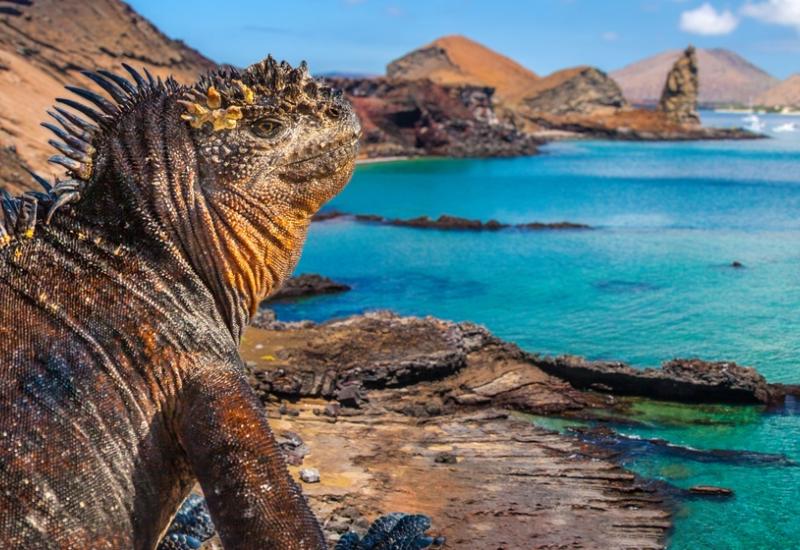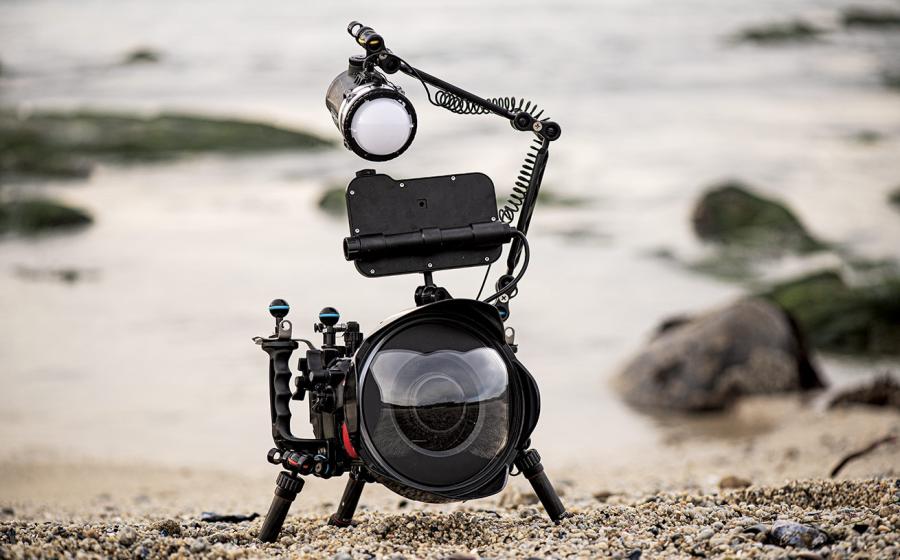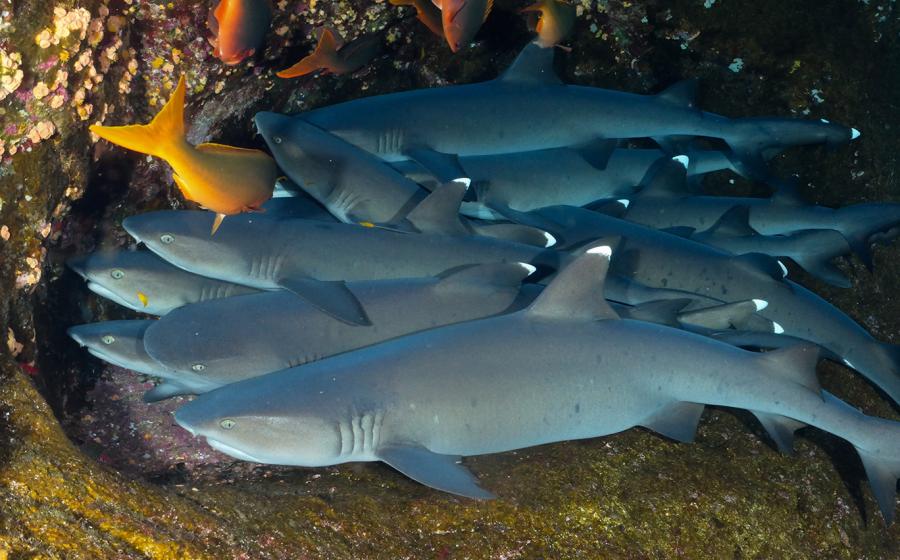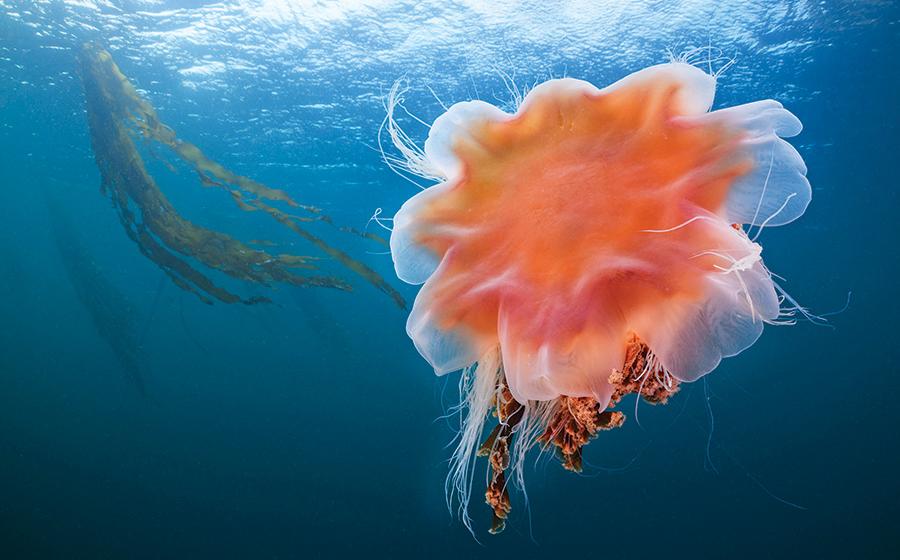Standout Stay: Galapagos Sky Liveaboard
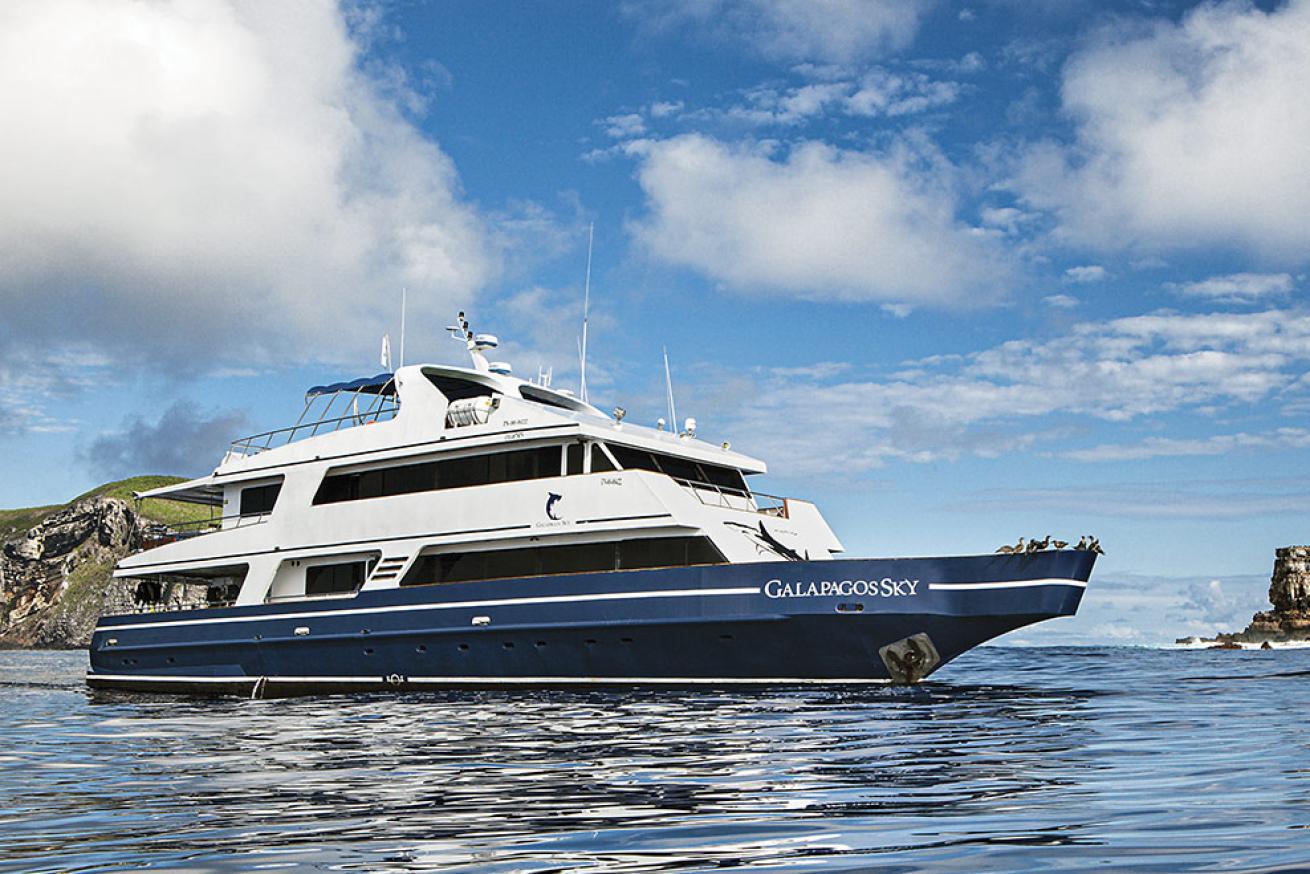
Michele WestmorelandThe Galapagos Sky at the iconic Darwin dive site.
There is no time to waste. The currents out at Darwin and Wolf, the best and most iconic dive sites of the Galapagos Marine Reserve, can be unforgiving. Our dive group descends immediately, not unlike aquatic astronauts, back-rolling into the depths of Shark Bay. Kicking fiercely, I barely have time to wedge myself behind a rock before I learn firsthand how the area earned its legendary reputation.
A scalloped hammerhead shimmies past, warily eyeing me while it visits a nearby cleaner wrasse for a quick polish. Soon, a school of at least a hundred hammers reveals itself out in the blue; it’s just a fraction of the sharks—the highest concentration in the world—that call the Galapagos Islands home. My buddy, a stoic former Marine, surfaces with tears fogging his mask.
“I’ve never seen the ocean like this before,” he tells me. “It is so alive.”
Related Reading: Don't Dive the Galapagos Without Reading This First
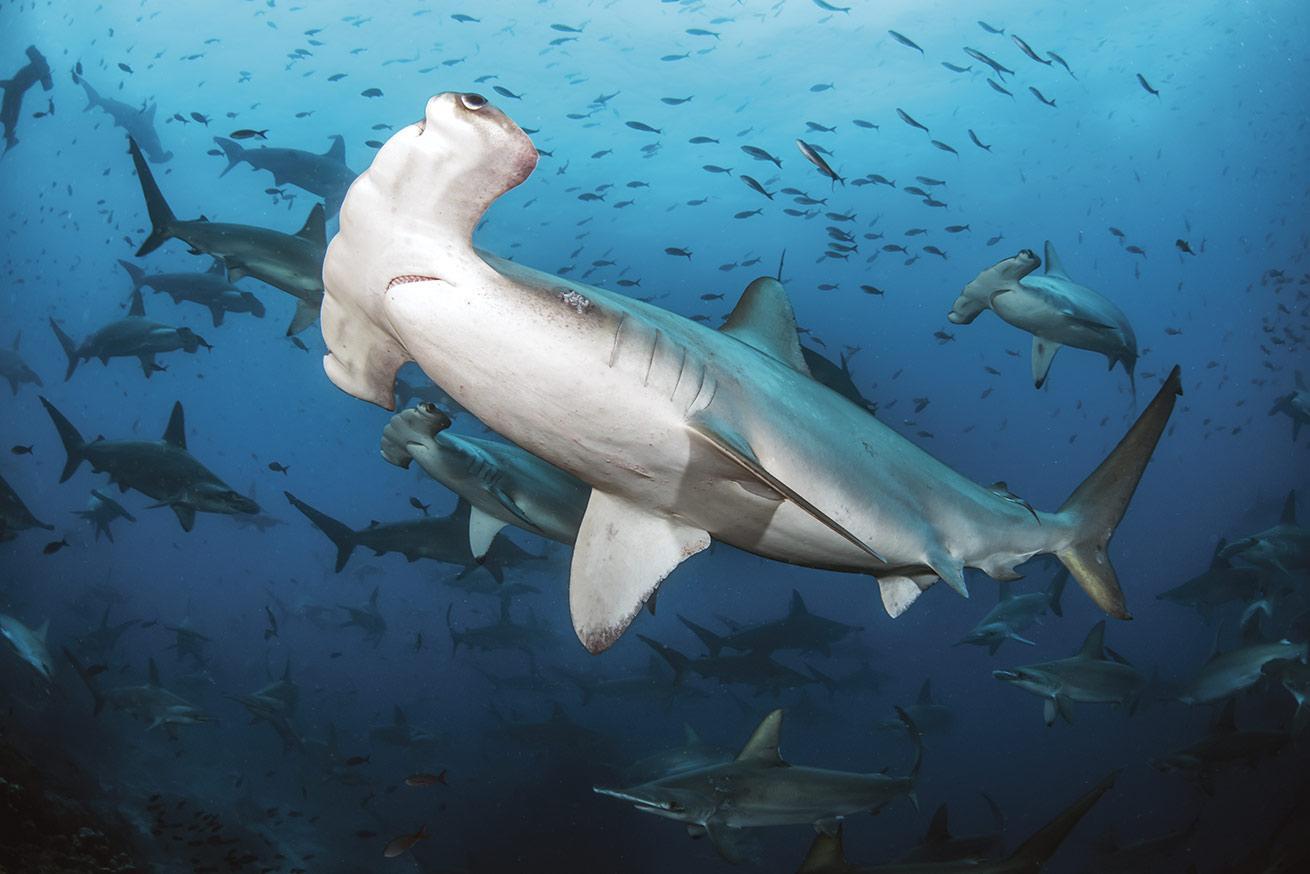
Courtesy Galapagos Sky/Dennis WhitestoneHammerheads school in the hundreds at a Galapagos dive site.
There’s magic to be found everywhere in the Galapagos. But to explore Darwin and Wolf, you must travel by liveaboard. Galapagos Sky, an eight-cabin purpose-built yacht, allows you to make the long journey to these remote islands in total comfort, spoiled by an attentive 11-member crew the whole way. (When the captain himself helps you unzip your wetsuit, you know it’s good service.)
The luxury dive yacht’s spacious design ensures that when you stow your fins for the day, the excitement isn’t over. The indoor and outdoor lounges offer room for reading a book from the library, watching movies on AppleTV and stargazing. I frequently find myself bird-watching on the sun deck, with or without a margarita from the open bar. Nazca and red-footed booby chicks that are testing their wings often make a crash landing next to my hammock.

Ollie ClarkeA diver fins alongside a whale shark in the blue.
Darwin’s Enchanted Isles
“This is the true Galapagos,” divemaster Max Castillo tells us as we arrive at Fernandina, the archipelago’s youngest and westernmost island. We’d just wrapped up three full days at Darwin and Wolf, where we experienced some of the sharkiest and most epic diving the ocean has to offer. While Castillo’s infectious passion for his homeland and its wildlife was impossible to ignore, it left many of us sincerely wondering: What could possibly be as good as a cloud of scalloped hammerheads?
I discover the answer creeping across the seabed: a red-lipped batfish. Decked out with a vermilion pucker that resembles plastic surgery gone wrong, the aptly named bottom dweller is one of the strangest (and most popular) sights for divers in the Galapagos. It walks ever so slowly using its pseudo-legs, dangling its illicium—a sort of “fishing pole” appendage on the head that’s thought to lure in prey—as our group takes pains not to stir up the sand and ruin the oddity’s moment in the spotlight. It can be hard to focus; I’m soon distracted by speckled Galapagos snake eels and “croaking” sea robins.
You’d be hard pressed to find a destination with more thrilling wildlife sightings than the Galapagos, gifted with nearly 3,000 marine species, roughly 20 percent of which are found nowhere else on Earth. From mola mola and bullhead sharks to flightless cormorants and tiny penguins, these remote islands offer an astounding amount of rare and charismatic animals for divers to admire.
Boring dives? They simply don’t exist here. If Galapagos Sky’s divemasters seem like they know these waters like their own backyard, that’s because all guides are Ecuadorian nationals, and 65 percent are Galapagos residents.
Most divers visit during whale shark season (June to November), when the gentle giants stop by Darwin and Wolf to feed on plankton. Since this time of year also means strong currents and chilly, choppy water, some divers prefer the milder offseason (December to May) and its parade of mantas.
Related Reading: 8 Things to Know Before Scuba Diving in Galapagos
Most divers visit during whale shark season (June to November) when the gentle giants stop by Darwin and Wolf to feed on plankton. Since this time of year also means strong currents and chilly, choppy water, some divers prefer the milder off-season (December to May) and its parade of mantas.
A Local, Eco-Friendly Option

Courtesy Galapagos Sky/Micahel Patrick O'NeillGalapagos penguins at Bartolome
In 2007, UNESCO added the Galapagos to its list of World Heritage Sites in danger, calling out overtourism, the introduction of alien species and illegal fishing, among other factors. As the number of tourists grows, so does the pressure to accommodate them with larger cruise ships, expanded tour options and sprawling, resort-style hotels that can harm the islands’ fragile ecosystem.
Fortunately for sustainably minded divers, Ecoventura—Galapagos Sky’s parent company and the first carbon neutral operation in Ecuador—remains committed to small-scale, responsible ecotourism. All boats meet a strict set of conservation and social standards, boasting reverse osmosis desalinization units that produce their own fresh water, biodegradable soaps and shampoos, and a waste management and garbage-recycling system.
Because the Galapagos Marine Reserve remains threatened by illegal fishing and shark finning, Ecoventura also works closely with the World Wildlife Fund to finance the Galapagos Marine Biodiversity Fund, which helps maintain park patrol boats and takes a stand against industrial-scale vessels that attempt to enter the park’s pristine waters.
Dive after dive, I see their efforts aren’t in vain. Silky sharks trail our boat and greet us with close, curious passes upon our return. Green sea turtles that haven’t learned to fear humans cruise through my bubbles so confidently I’m forced to duck my head to avoid them. During one unforgettable dive at No Name Rock near Pinzon Island, I lose myself in a school of black-striped salema so big they morph into a silvery maze.
Suddenly, I feel the grip of a swift current. Instead of swimming away, Castillo encourages me to fin directly into it. There’s a thrill in letting go; the ride is nothing short of an aquatic roller coaster that rips past a Galapagos sea lion, reef sharks and barracuda and spits me out next to my group, who are now pointing frantically at something so large it blots out the sun: a giant manta ray.
Related Reading: An Unforgettable Dive: More Mantas Please
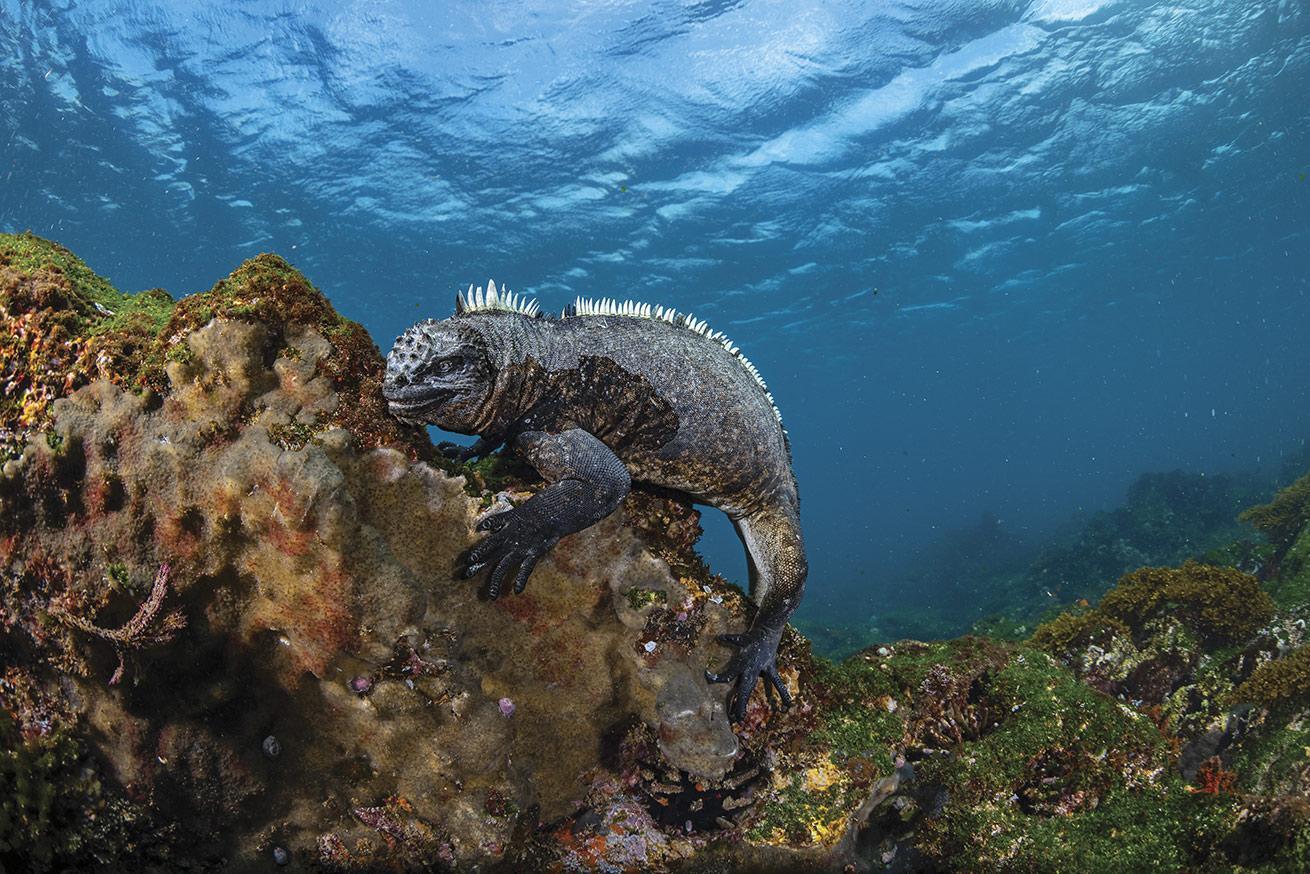
Brooke PykeA marine iguana, unique among lizards for its ability to forage at sea for algae.
A Galapagos Icon
Some divers venture to the Galapagos yearning to meet Godzilla himself. The world’s only seafaring lizard, marine iguanas can stay submerged for up to 30 minutes in order to feed on the algae covering underwater rocks. The best place to dive with them is at Cabo Douglas on the far eastern side of Fernandina. There, we fumble in the heavy surge for an hour, watching the graceful reptiles graze and effortlessly propel themselves with their flattened tails. The iguanas—with their salt-encrusted heads—are a triumph of evolution, proof that while we cling to our BCs, nature has more elegant solutions.
Courtesy Galapagos Sky/Brandon ColeTwo juvenile Galapagos sea lions frolic underwater.
On almost any other dive trip, this moment would become lore, rehashed and remembered fondly each night over dinner. But in the Galapagos, it is just one example of what we are privileged to experience. We spend our safety stops playing with dolphins and Galapagos sea lions. Fur seal pups with saucer-size eyes reminiscent of Pokemon nip at our fins and twirl through our bubbles, chasing us back to our Zodiac when we run out of air. It seems they are as disappointed as we are that the games must eventually end.
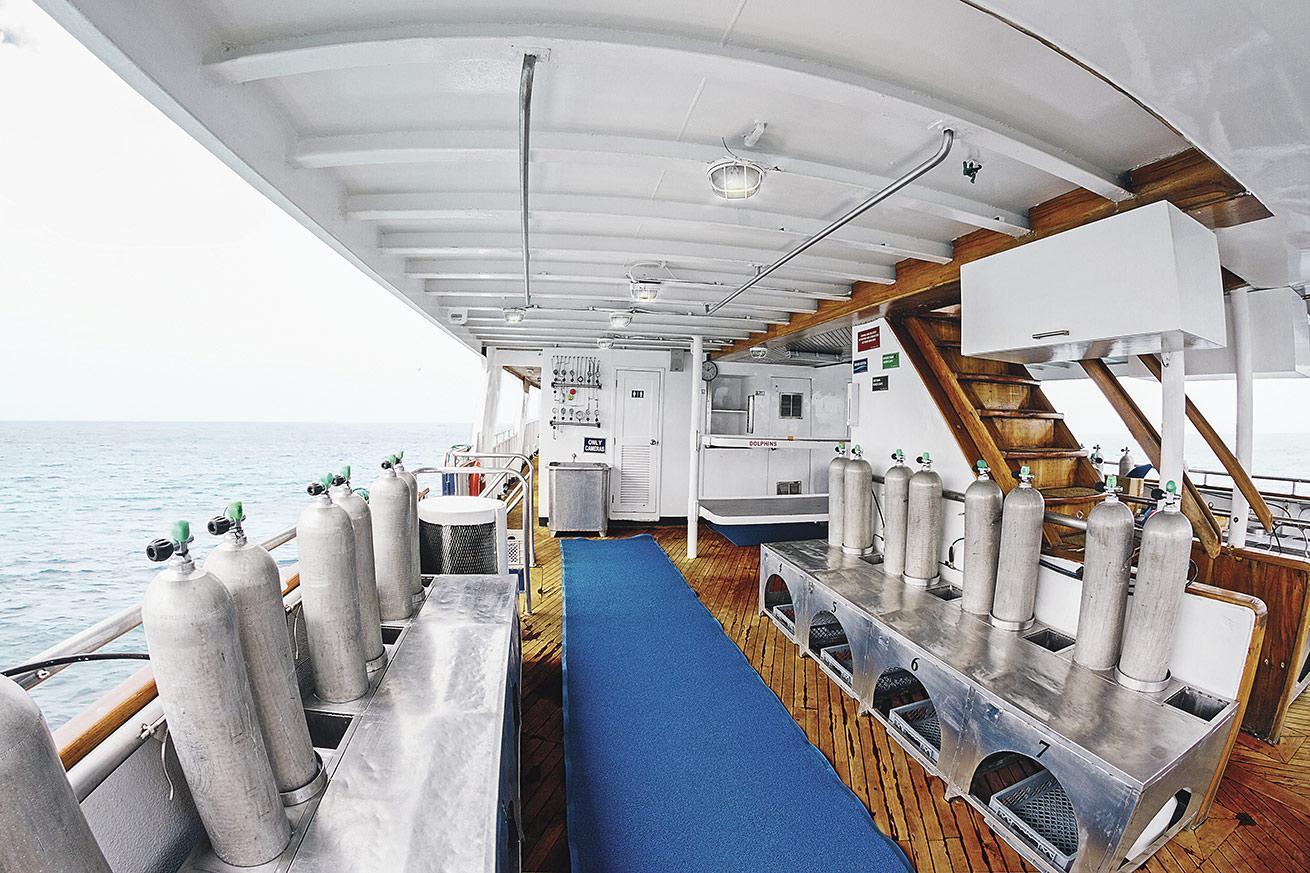
Courtesy Galapagos SkyThe spacious dive deck aboard Galapagos Sky.
Need to Know
When to Go
The Galapagos is truly a year-round destination. Pick the wet season (December to May) for mantas and the dry season (June to November) for whale sharks.
Conditions
In the wet season, expect water temperatures between 65 and 80 degrees; during the dry season, the water cools to 60 to 77 degrees. Average visibility ranges from 30 to 70 feet, worsening in the dry season.
Topside Fun
Galapagos Sky’s itinerary offers three land excursions, including a hike around North Seymour Island, a prime spot to witness blue-footed boobies and magnificent frigate birds’ courtship rituals, as well as a visit to the Galapagos Tortoise Reserve with free time in the charming town of Puerto Ayora, Santa Cruz. The trip ends with a tour of the Interpretation Center in San Cristobal, a small museum dedicated to natural history in the Galapagos.
Certifications/Requirements
All divers are required to show proof of an enriched air nitrox certification to dive at Darwin and Wolf due to recreational no-decompression limits. (Note that nitrox classes are not available on board). It’s recommended divers have at least 100 dives and have training in currents and cold water. Galapagos Sky can arrange a private dive guide for $1,950 for the seven-night itinerary.
Gear
Because of advanced diving conditions, Galapagos Sky recommends divers bring their own proper-fitting gear (most divers opt for a 7 mm wetsuit). A limited number of 7 mm wetsuits, BCDs, fins and regulators are available to rent. You’ll also want to pack gloves and a hood or hooded vest for extra thermal protection.
Pricing
In 2025, a seven-night cruise on Galapagos Sky costs $7,395 per person for a deluxe (lower deck) cabin and $7,695 per person for a master (upper deck) cabin. This rate includes accommodations, food, beverages, tanks, weights, nitrox, up to four dives per day, land excursions and airport transfers.
Contact: galapagossky.com
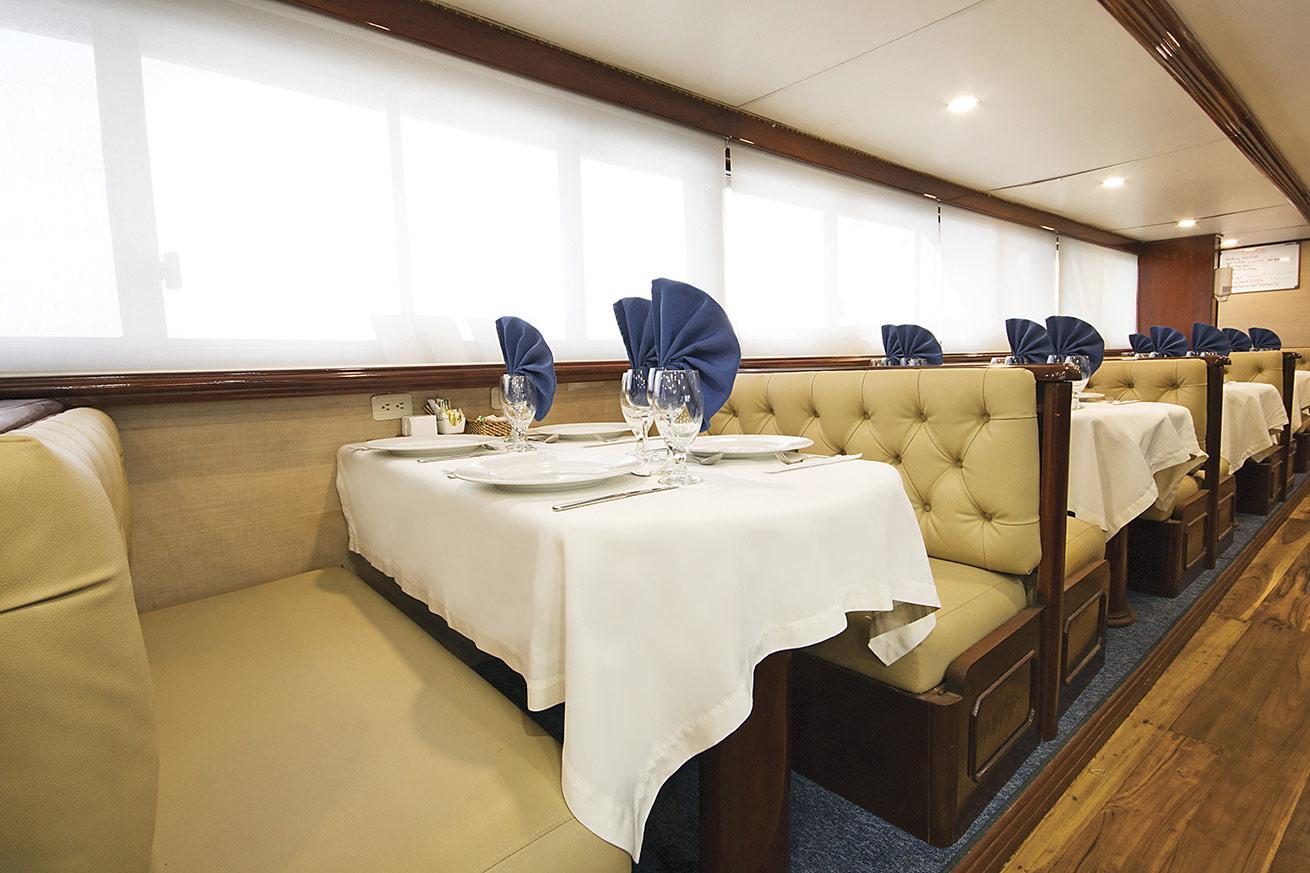
Courtesy Galapagos SkyThe boat’s dining area.
The Galapagos Sky
Length
100 feet
Passenger-To-Staff Ratio
16 to 11
Staterooms/Beds
The yacht’s eight cabins are cozy and clean, with en suite bathrooms and plenty of space for storage. Pro tip: Spend a little more for a room on the upper deck, where you’ll get extra square footage, a king bed and scenic views through massive picture windows.
Amenities
Galapagos Sky is equipped with a camera table and charging station on the dive deck, indoor and outdoor lounges, two flat-screen TVs with Apple TV (perfect for showing off your photos), an ample video and book library, and a sun deck with hammocks.
Food/Drink
Most meals are a generous buffet of Ecuadorian and international dishes, while dinner is served plated. An open bar (excluding premium liquors and wines) is included.
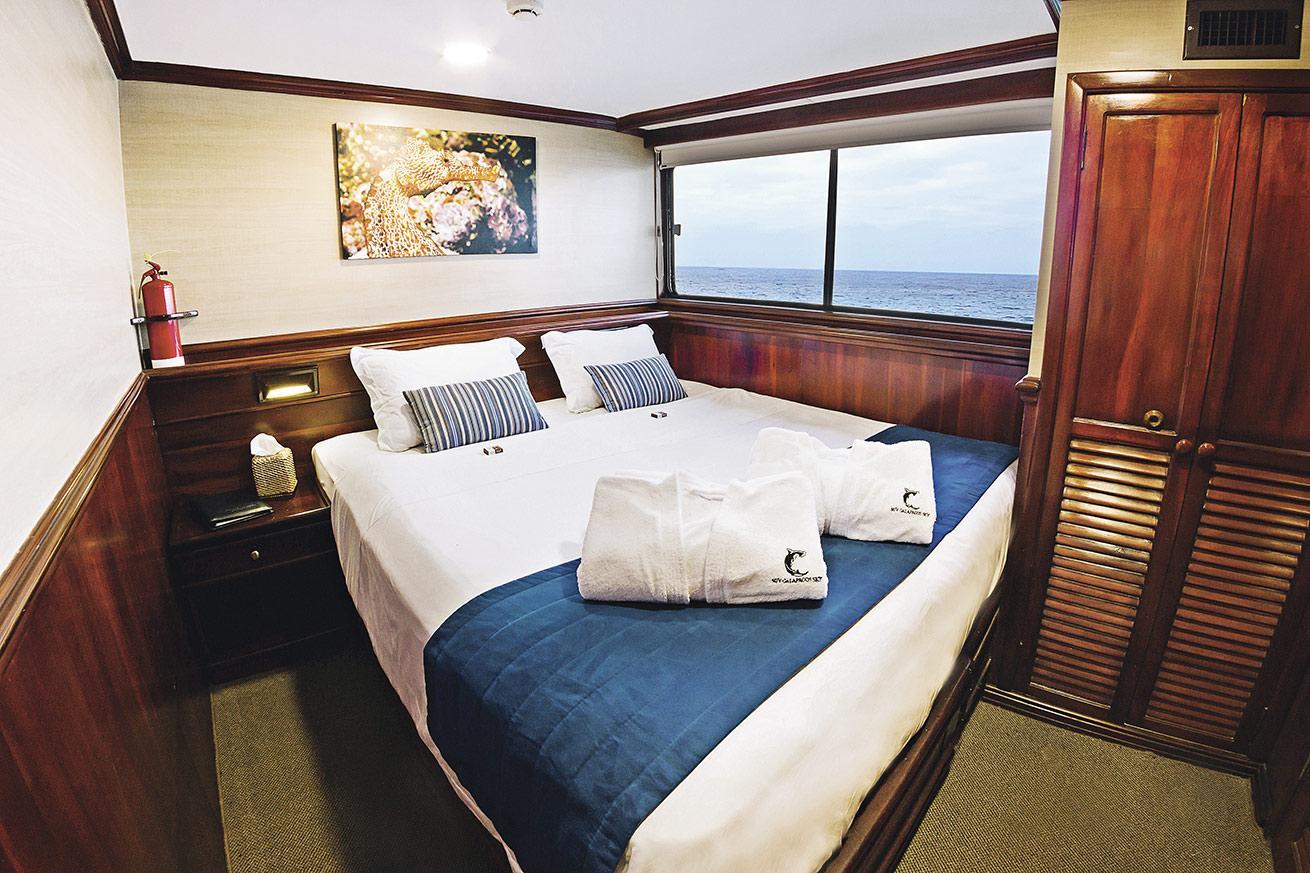
Courtesy Galapagos SkyA master upper deck cabin complete with a king bed and picture windows with a view.



